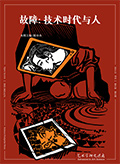

在数字资本主义的语境下, 数字生产作为一种非物质自动化生产能够极其快捷而隐蔽地进行, 几乎所有生产实践都被数字光环所笼罩, “后数字美学”是在对势不可挡的、完美的数字符码的不断发问中形成的, 这一系列的艺术生产实践就包含了故障艺术。“后数字”不是“反数字”, 也不是数字极度泛滥后的幻灭, 后数字时代是一种人类和数字以各种方式、不同程度合二为一的数字时代。本文通过梳理工业资本主义和数字资本主义间的天然连结、类比对摄影术的哲学反思, 以重新理解作为机器-装置复合体的“后人类”, 认为“后人类化”的过程早在工业流水线的实现甚至摄影产生之时就初见端倪。同时, 数字生产是一个“负熵”的过程, 而故障与断裂则顺应了“熵增”, 是数字系统中恒常存在的潜在可能, 它们像突发的症候, 令数字机器进入“谵妄”的状态。故而, 故障艺术的美可以理解为一种“谵妄”的美, 蕴含着叛逆性与批判性。故障艺术是一种复合艺术, 它的创作应发挥数字技术的潜力, 将创作者的精神理念渗透到数字的层层迭代中, 在中断中寻找永恒, 在错误中生成绮丽。
In the context of digital capitalism, digital production, as a form. of immaterial automated production, can be executed agilely and unobtrusively. Almost all forms of production are overshadowed by this digital aura. “Post-digital aesthetics” emerges from a series of artistic practices that interrogate the overwhelming perfection of digital symbols, and this series of artistic production practices includes glitch art. The term “post-digital” does not refer to “anti-digital”, nor does it imply disillusionment following the excessive proliferation of digital technologies. Rather, the post-digital era represents a time in which human being and digital apparatus are integrated in various ways and to varying extents. This paper attempts to reinterpret the definition of the “post-human” as a complex of machines and devices by examining the intrinsic connections between industrial capitalism and digital capitalism, and drawing an analogy with philosophical and critical reflection on photography. It argues that the process of “post-humanization” can be traced back to the early development of industrial assembly lines and the invention of photographic technologies. Furthermore, digital production is characterized as a process of “negative entropy, ” while disruptions and glitches conform. to the “increase-in-entropy”, constituting an inherent potential in digital systems. These disruptions resemble sudden symptoms, inducing a state of delirium in digital machines. Therefore, the beauty of glitch art can be interpreted as a kind of “delirious” beauty, encompassing the elements of rebellion and critique. Glitch art, as a complex form. of artistic expression, should harness the potential of digital technologies, embedding the creators intellectual concepts into the iterative processes of the digital systems, searching for the eternal within interruptions, and generating brilliance from errors.